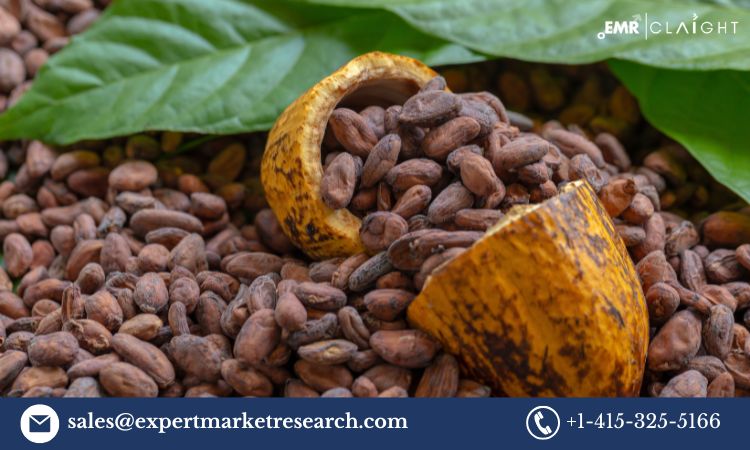The cocoa market is a vital component of the food and beverage industry, fueling the production of various products such as chocolate, cocoa powder, and cocoa butter. As of 2024, the cocoa market is valued at approximately USD 26.70 billion, and it is expected to grow at a compound annual growth rate (CAGR) of 4.70% between 2025 and 2034. By 2034, the market is projected to reach a value of USD 42.26 billion. This article will explore the global cocoa market in-depth, including its size, share, dynamics, growth drivers, opportunities, challenges, and key players.
Overview of the Global Cocoa Market
Cocoa is one of the most widely consumed ingredients in the world, particularly due to its essential role in the chocolate industry. Derived from the seeds of the cacao tree (Theobroma cacao), cocoa is used in various forms, including cocoa powder, cocoa butter, and cocoa liquor, for the production of a wide range of products. The global demand for cocoa is mainly driven by the increasing consumption of chocolate and other cocoa-based products, as well as the rising popularity of cocoa for its health benefits.
Cocoa is produced primarily in tropical regions, with the top producers being Côte d’Ivoire (Ivory Coast), Ghana, and Indonesia. The market is influenced by various factors such as global demand for chocolate, shifting consumer preferences, sustainability concerns, and the impacts of climate change on cocoa production. With the rising demand for high-quality chocolate and the growing importance of ethical sourcing, the cocoa industry is evolving to meet consumer expectations for traceability and sustainability.
Size & Share of the Global Cocoa Market
In 2024, the global cocoa market was valued at approximately USD 26.70 billion. The market’s growth can be attributed to the continued demand for chocolate, especially premium products and dark chocolate, which contain higher cocoa content. The growing interest in cocoa-based health products, such as cocoa powder and cocoa butter for skincare and wellness, is also contributing to the overall expansion of the market.
The global cocoa market is expected to grow at a CAGR of 4.70% between 2025 and 2034. By the end of the forecast period, the market is projected to reach a value of USD 42.26 billion. The increasing population and the expanding middle class in emerging markets like Asia-Pacific and Latin America are expected to further drive the demand for cocoa and cocoa-based products.
Regionally, the cocoa market is primarily driven by Europe, North America, and Asia-Pacific. Europe remains the largest consumer of cocoa, especially due to the high demand for chocolate. North America is a major market for cocoa due to the growing consumption of chocolate and its use in food and beverage products. Asia-Pacific, however, is expected to experience the highest growth rate in the coming years, fueled by increasing disposable income, a rising middle class, and growing demand for premium chocolate.
Market Dynamics & Trends in the Cocoa Industry
Several dynamics and trends are shaping the cocoa market, which is being influenced by consumer behavior, technological advancements, and regulatory changes.
- Rising Demand for Premium and Dark Chocolate :One of the key trends in the cocoa market is the increasing preference for premium and dark chocolate. Dark chocolate, which contains higher cocoa content, has gained popularity due to its health benefits, such as being rich in antioxidants. Consumers are becoming more conscious of the nutritional value of the products they consume, driving the demand for chocolates with higher cocoa content. As a result, cocoa manufacturers are focusing on producing high-quality cocoa to meet this demand.
- Sustainability and Ethical Sourcing :Sustainability has become a significant concern in the cocoa market, with increased focus on ethical sourcing and fair trade practices. The cocoa industry has faced criticism over child labor, deforestation, and poor working conditions in some of the largest cocoa-producing regions. In response, several companies are adopting sustainable practices, promoting traceability, and working with farmers to ensure that cocoa is produced under ethical conditions. Consumers are also increasingly supporting brands that source cocoa sustainably, driving this trend further.
- Health Benefits of Cocoa :Cocoa, particularly dark chocolate, is often touted for its health benefits, including improving heart health, reducing inflammation, and providing a source of antioxidants. As consumers become more health-conscious, they are seeking out cocoa-based products that offer these benefits. This trend has encouraged the development of new products such as cocoa-infused beverages, cocoa-based snacks, and dietary supplements containing cocoa extracts.
- Innovation in Cocoa-based Products :Innovation in cocoa-based products is another key trend in the market. Manufacturers are exploring new applications for cocoa beyond chocolate, including using cocoa powder and cocoa butter in cosmetics, personal care products, and pharmaceuticals. The rise of plant-based diets and veganism has also led to the introduction of dairy-free chocolate products made with plant-based cocoa alternatives, creating new opportunities for cocoa producers.
- Climate Change and Impact on Cocoa Production :Climate change poses a significant challenge to cocoa production. Cocoa is a highly climate-sensitive crop, and the changing weather patterns, such as increased rainfall, rising temperatures, and droughts, are affecting cocoa-growing regions. This has led to concerns about supply chain disruptions and price fluctuations in the cocoa market. To mitigate these effects, cocoa producers are investing in climate-resilient farming techniques and crop diversification.
Growth of the Global Cocoa Market
The global cocoa market is poised for strong growth in the coming years, driven by several key factors:
- Rising Demand in Emerging Markets :Emerging markets, particularly in Asia-Pacific, are seeing a surge in demand for cocoa products. As disposable incomes rise and the middle class expands, more consumers are able to afford premium products like chocolate. The increasing urbanization and Westernization of diets in countries like China and India are contributing to this growing demand for cocoa-based products.
- Shift Toward Healthier Products :There is an increasing shift toward healthier food options, which has positively impacted the cocoa market. The demand for dark chocolate, cocoa-based health foods, and low-sugar chocolates is on the rise. This trend is driving growth in the cocoa market, as consumers are looking for healthier alternatives without sacrificing taste.
- Investment in Sustainable Farming :Sustainability is a growing priority for both cocoa producers and consumers. Increased investment in sustainable farming practices and certifications, such as Fair Trade and Rainforest Alliance, is helping to improve the long-term viability of cocoa production. This trend is attracting both investors and consumers who prioritize sustainability and ethical practices in their purchasing decisions.
- Increased Use of Cocoa in Other Industries :Cocoa is increasingly being used in industries beyond chocolate, including cosmetics, pharmaceuticals, and personal care products. Cocoa butter, for example, is widely used in moisturizers, lip balms, and lotions. The versatility of cocoa products is creating new growth opportunities for producers in non-food sectors.
Get a Free Sample Report with a Table of Contents:
https://www.expertmarketresearch.com/reports/cocoa-market/requestsample
Market Opportunities and Challenges
While the cocoa market offers numerous opportunities for growth, there are also significant challenges that market players must navigate.
Opportunities
- Expansion in Asia-Pacific The Asia-Pacific region presents a significant growth opportunity for the cocoa market, as increasing incomes, changing lifestyles, and a growing appetite for chocolate contribute to the rise in demand for cocoa-based products.
- Health-focused Cocoa Products The rising consumer preference for healthier chocolate and cocoa-based products presents an opportunity for companies to innovate and create products that meet the demand for low-sugar, high-cocoa, and functional foods.
- Sustainable Practices Adopting sustainable farming and sourcing practices is not only an ethical responsibility but also a business opportunity. As consumer preferences shift toward ethically sourced products, cocoa producers can gain a competitive edge by ensuring traceability and transparency in their supply chains.
Challenges
- Climate Change The impact of climate change on cocoa production remains a significant challenge. Unpredictable weather patterns and changing growing conditions could lead to supply shortages and price volatility in the market.
- Child Labor and Ethical Issues Child labor and unethical practices in cocoa production, particularly in West Africa, are significant concerns. Addressing these issues requires continued efforts to promote fair trade practices, improve working conditions, and support cocoa farmers in producing cocoa sustainably.
- Price Volatility Cocoa prices are volatile and can fluctuate due to factors such as supply chain disruptions, weather conditions, and market speculation. These fluctuations can make it difficult for cocoa producers and manufacturers to predict costs and maintain stable pricing for consumers.
Competitor Analysis: Key Players in the Cocoa Market
Several major companies dominate the cocoa market, offering a range of products from raw cocoa beans to processed cocoa products. These players are investing in innovation, sustainability, and global expansion to maintain their competitive edge.
- ECOM Agroindustrial Corp. Limited :ECOM Agroindustrial is a global leader in the cocoa industry, involved in the procurement, processing, and distribution of cocoa. The company is known for its commitment to sustainability and has programs in place to support farmers and improve the quality of cocoa production.
- PRONATEC AG :PRONATEC is a leading supplier of high-quality cocoa and cocoa derivatives. The company is known for its sustainable practices and direct relationships with cocoa farmers, ensuring that its products meet high-quality standards while supporting ethical sourcing.
- Blommer Chocolate Company :Blommer Chocolate Company is one of the largest cocoa processors in North America. It supplies a wide range of cocoa and chocolate products to the food industry, with a focus on sustainability, quality, and innovation in product offerings.
- Crown of Holland (Tradin Organic Agriculture B.V.) :Crown of Holland, under the umbrella of Tradin Organic Agriculture, is a major player in the cocoa market, offering organic cocoa products. The company focuses on sustainable and ethical sourcing practices and serves a growing demand for organic and fair trade-certified cocoa.
- Others :Other key players in the cocoa market include Nestlé S.A., Mars, Inc., Ferrero Group, and Olam Group. These companies are focused on expanding their product offerings, enhancing sustainability efforts, and meeting the growing demand for high-quality cocoa.
Explore our trending Blogs and Reports :
Toy manufacturers
HVAC Variable Frequency Drive Market



